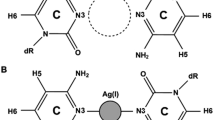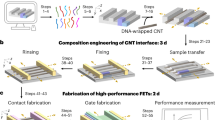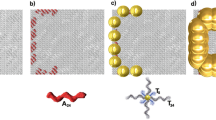Abstract
Recent research in the field of nanometre-scale electronics has focused on two fundamental issues: the operating principles of small-scale devices, and schemes that lead to their realization and eventual integration into useful circuits. Experimental studies on molecular1 to submicrometre2 quantum dots and on the electrical transport in carbon nanotubes3,4,5 have confirmed theoretical predictions6,7,8 of an increasing role for charging effects as the device size diminishes. Nevertheless, the construction of nanometre-scale circuits from such devices remains problematic, largely owing to the difficulties of achieving inter-element wiring and electrical interfacing to macroscopic electrodes. The use of molecular recognition processes and the self-assembly of molecules into supramolecular structures9,10 might help overcome these difficulties. In this context, DNA has the appropriate molecular-recognition11 and mechanical12,13,14,15,16 properties, but poor electrical characteristics prevent its direct use in electrical circuits. Here we describe a two-step procedure that may allow the application of DNA to the construction of functional circuits. In our scheme, hybridization of the DNA molecule with surface-bound oligonucleotides is first used to stretch it between two gold electrodes; the DNA molecule is then used as a template for the vectorial growth of a 12 µm long, 100 nm wide conductive silver wire. The experiment confirms that the recognition capabilities of DNA can be exploited for the targeted attachment of functional wires.
This is a preview of subscription content, access via your institution
Access options
Subscribe to this journal
Receive 51 print issues and online access
$199.00 per year
only $3.90 per issue
Buy this article
- Purchase on Springer Link
- Instant access to full article PDF
Prices may be subject to local taxes which are calculated during checkout




Similar content being viewed by others
References
Porath, D. & Milloh, O. Single electron tunneling and level spectroscopy of isolated C60molecules. J. Appl. Phys. 81, 1–4 (1997).
Meirav, U. & Foxman, E. B. Single-electron phenomena in semiconductors. Semiconductor Sci. Technol. 11, 255–284 (1996).
Langer, L. et al. Quantum transport in a multiwalled carbon nanotube. Phys. Rev. Lett. 76, 479–482 (1996).
Tans, S. J. et al. Individual single-wall carbon nanotubes as quantum wires. Nature 386, 474–477 (1997).
Bockrath, M. et al. Single-electron transport in ropes of carbon nanotubes. Science 275, 1922–1925 (1997).
Averin, D. V. & Likharev, K. K. in Mesoscopic Phenomena in Solids (eds Altshuler, B., Lee, P. & Webb, R.) 173 (Elsevier, Amsterdam, (1991)).
Grabert, H. & Devoret, M. (eds) Single Charge Tunneling (Plenum, New York, (1992)).
Kastner, M. A. The single-electron transistor. Rev. Mod. Phys. 64, 849–858 (1992).
Lehn, J. M. Supramolecular Chemistry: Concepts and Perspectives (VCH, Weinheim, (1995)).
Atwood, J. L. et al. (eds) Comprehensive Supramolecular Chemistry (Pergamon, Oxford, (1996)).
Watson, J. D. et al. Molecular Biology of the Gene 4th edn (Benjamin Cummings, Menlo Park, (1987)).
Austin, R. H. et al. Stretch genes. Phys. Today 50, 32–38 (1997).
Bensimon, D. et al. Stretching DNA with a receding meniscus: Experiments and models. Phys. Rev. Lett. 74, 4754–4757 (1995).
Bensimon, A. et al. Alignment and sensitive detection of DNA by a moving interface. Science 265, 2096–2098 (1994).
Wirtz, D. Direct measurement of the transport properties of a single DNA molecule. Phys. Rev. Lett. 75, 2436–2439 (1995).
Zimmerman, R. M. & Cox, E. C. DNA stretching on functionalized gold surfaces. Nucleic Acids Res. 22, 492–497 (1994).
Schwartz, D. C. & Koval, M. Conformational dynamics of individual DNA molecules during gel electrophoresis. Nature 338, 520–522 (1989).
Barton, J. K. in Bioinorganic Chemistry (eds Bertini, I. et al.) ch. 8 (University Science Books, Mill Valley, (1994)).
Spiro, T. G. (ed.) Nucleic Acid–Metal Ion Interactions (Wiley Interscience, New York, (1980)).
Marzilli, L. G., Kistenmacher, T. J. & Rossi, M. J. Am. Chem. Soc. 99, 2797–2798 (1977).
Eichorn, G. L. (ed.) Inorganic Biochemistry Vol. 2, ch. 33–34 (Elsevier, Amsterdam, (1973)).
Holgate, C. S. et al. Immunogold-silver staining: new method of immunostaining with enhanced sensitivity. Histochem. Cytochem. 31, 938–944 (1983).
Birrell, G. B. et al. Silver-enhanced colloidal gold as a cell surface marker for photoelectron microscopy. J. Histochem. Cytochem. 34, 339–345 (1986).
Hall, B. D., Holmlin, R. E. & Barton, J. K. Oxidative DNA damage through long-range electron transfer. Nature 382, 731–735 (1996).
Arkin, M. R. et al. Rates of DNA-mediated electron transfer between metallointercalators. Science 273, 475–480 (1996).
Lewis, F. D. et al. Distance-dependent electron transfer in DNA hairpins. Science 277, 673–676 (1997).
Mirkin, C. A. et al. ADNA-based method for rationally assembling nanoparticles into macroscopic materials. Nature 382, 607–609 (1996).
Alivisatos, A. P. et al. Organisation of ‘nanocrystal molecules’ using DNA. Nature 382, 609–611 (1996).
Coffer, J. L. et al. Dictation of the shape of mesoscale semiconductor nanoparticle assemblies by plasmid DNA. Appl. Phys. Lett. 69, 3851–3853 (1996).
Burroughes, J. H. et al. Light-emitting diodes based on conjugated polymers. Nature 347, 539–541 (1990).
Acknowledgements
We thank T. Haran, A. Admon, W. Kaplan and S. Lipson for discussions and technical assistance.
Author information
Authors and Affiliations
Corresponding author
Rights and permissions
About this article
Cite this article
Braun, E., Eichen, Y., Sivan, U. et al. DNA-templated assembly and electrode attachment of a conducting silver wire. Nature 391, 775–778 (1998). https://doi.org/10.1038/35826
Received:
Accepted:
Issue Date:
DOI: https://doi.org/10.1038/35826
This article is cited by
-
Photocatalytic, Antibacterial, Cytotoxic and Bioimaging Applications of Fluorescent CdS Nanoparticles Prepared in DNA Biotemplate
Journal of Fluorescence (2024)
-
Fabrication of copper oxide nanoparticles immobilized onto deoxyribonucleic acid template: application for electrochemical detection of 2,4-dichlorophenoxyacetic acid
Journal of the Iranian Chemical Society (2023)
-
Kinetics and Mechanism of In Situ Metallization of Bulk DNA Films
Nanoscale Research Letters (2022)
Comments
By submitting a comment you agree to abide by our Terms and Community Guidelines. If you find something abusive or that does not comply with our terms or guidelines please flag it as inappropriate.



